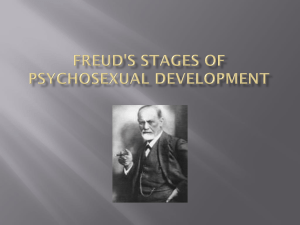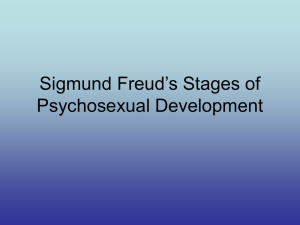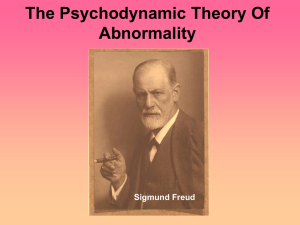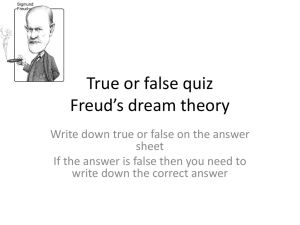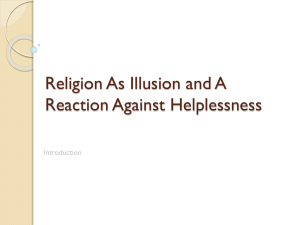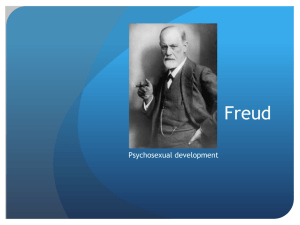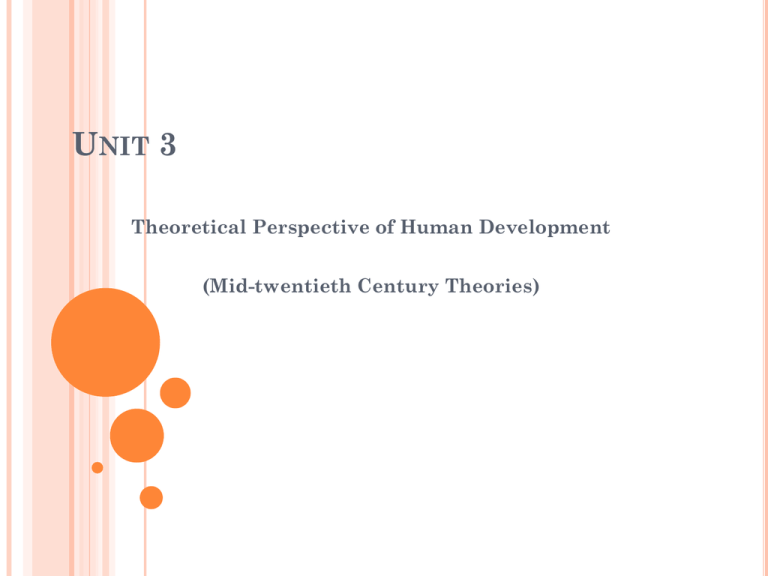
UNIT 3
Theoretical Perspective of Human Development
(Mid-twentieth Century Theories)
OVERVIEW
Psychoanalytic Perspective
Psychosexual
Psychosocial
Mechanistic Perspective
Behaviorism
Social Learning
Organismic Perspective
Cognitive Development
Humanistic Perspective
Self Actualization
PSYCHOANALYTIC PERSPECTIVE
Explains personality,
motivation, and psychological
disorders by focusing on:
the influence of early
childhood experiences
unconscious motives
and conflicts
methods people use
to cope with their sexual and
aggressive impulses
Freud’s determinism
PSYCHOANALYTIC PERSPECTIVE
Psychoanalytic theory suggests that
unconscious forces act to determine personality
and behavior.
The unconscious is a part of the personality about
which a person is unaware.
It contains infantile wishes, desires, demands and
needs that are hidden, because of their disturbing
nature, from conscious awareness.
The unconscious is responsible for a good part of
our everyday behavior.
Our personality has three aspects: the id, the ego
and the superego.
THE PSYCHOANALYTIC PERSPECTIVE
Freud’s Structural Model of Personality
Id
- Operates on the pleasure
principle
- Demands immediate fulfillment
Superego
- Internalized ideals
- Develops from parents/ early
childhood experiences
THE PSYCHOANALYTIC PERSPECTIVE
Freud’s Structural Model of Personality
Ego
- Largely conscious
- Mediates demands of id and
ego
- Reality principle
Satisfy id in realistic
ways that bring
pleasure and not pain
FREUD’S STRUCTURAL MODEL OF
PERSONALITY
Id (Pleasure Principle)
We are born with our Id, which is an important part
of our personality. Id allows to get our basic needs
meet.
Id is based on our pleasure principle. In other words,
the id wants whatever feels good at the time, with no
consideration for the reality of the situation.
When a child is hungry, the id wants food, and
therefore the child cries. When the child needs to be
changed, the id cries. When the child is
uncomfortable, in pain, too hot, too cold, or just wants
attention, the id speaks up until his or her needs are
met.
The id doesn't care about reality, about the needs of
anyone else, only its own satisfaction.
FREUD’S STRUCTURAL MODEL OF PERSONALITY
Ego (Reality Principle)
Within the next three years, as the child
interacts more and more with the world, the
second part of the personality begins to develop,
the Ego.
The ego is based on the reality principle. The
ego understands that other people have needs
and desires and that sometimes being impulsive
or selfish can hurt us in the long run.
It’s the ego's job to meet the needs of the id, while
taking into consideration the reality of the
situation
FREUD’S STRUCTURAL MODEL OF PERSONALITY
Superego (Moral Principle)
By the age of five, or the end of the phallic stage
of development, the Superego develops.
The Superego is the moral part of us and
develops due to the moral and ethical restraints
placed on us by our caregivers.
Many equate the superego with the conscience as
it dictates our belief of right and wrong.
FREUD’S STRUCTURAL MODEL OF PERSONALITY
In a healthy person, according to Freud, the ego
is the strongest so that it can satisfy the needs of
the id, not upset the superego, and still take into
consideration the reality of every situation.
Not an easy job by any means, but if the id gets
too strong, impulses and self satisfaction take
over the person's life.
If the superego becomes to strong, the person
would be driven by rigid morals, would be
judgmental and unbending in his or her
interactions with the world.
THE PSYCHOANALYTIC PERSPECTIVE
PSYCHOSEXUAL THEORY: BASIC ASSUMPTION
The basic assumption is that human beings are
powerful innate forces known as instincts or
drives.
Instincts or drives energizes and direct all human
psychic and physical activities.
Libido is physiological and emotional energy
associated with the sex drive.
The concept was originated by Sigmund Freud,
who saw the libido as linked not only with sexual
desire but with all constructive human activity.
He believed that psychiatric illnesses were the
result of misdirecting or suppressing the libido.
LIBIDO AND THE PSYCHO-SEXUAL THEORY
Psychosexual developmental theory places great
emphasis on the psychology of sexual development.
Freud believed that sexual development was more
psychological in nature than it was biological.
Our sex drive (libido) causes us to seek pleasure in
erogenous zones (mouth, the genitals, & the anus)
during the different stages of psychosexual
development.
FREUD PSYCHO-SEXUAL THEORY
Libido means sex drive
FREUDIAN DEVELOPMENTAL PROCESS
Biological and psychological instincts and drives are
present at birth in the form of hunger and
discomfort and these drives are housed in Id.
The Id operates on the ‘pleasure principle’ (gain
pleasure and avoid displeasure)
Id seeks instant gratification of its drives or
needs.
Ego develops some 6-8 months after birth (Reality
Principle)
Superego develops (between 3-5 years) and becomes
the articulated moral principle.
Id, Ego, and Superego constitute Freudian
personality structure with amazing dynamics.
FREUD PSYCHO-SEXUAL THEORY
ORAL Stage This occurs from birth to about 1
year, and the libido is focused on the mouth. The
individual may be frustrated by having to wait
on another person, being dependent on another
person. Being fixated at this stage may mean an
excessive use of oral stimulation, such as
cigarettes, drinking or eating.
ORAL FIXATION
FREUD PSYCHO-SEXUAL THEORY
ANAL Stage This period occurs about age 2 and
3 yrs. Here individuals have their first encounter
with rules and regulations, as they have to learn
to be toilet trained. This encounter with rules and
regulations will dictate the later behavior with
rules and regulations.
FREUD PSYCHO-SEXUAL THEORY
ANAL STAGE (CONTINUE……)
These things are not just related to toilet training
but also the baby must learn to control urges and
behaviors. What goes wrong here is either
parents being too controlling or not controlling
enough.
Anally retentive person is rigid, overly organized,
subservient to authority vs. anally expulsive
person is little self-control, disorganized, defiant,
hostile.
ANAL STAGE (CONTINUED)
ANAL RETENTIVE VS. ANAL EXPULSION
FREUD PSYCHO-SEXUAL THEORY
PHALLIC Stage
This period starts about age 4-5 years. The libidinal
energy shifts from the anal region to the genital region.
Some critical episodes for development occur during this
stage, but these episodes occur differently for boys and
girls.
Oedipus conflict or Electra complex develop in boys
and girls.
The boy begins to fall in love with his mother, and
sees his father as a rival for her affections.
Similarly, girls become nearer to father. But she is
not against her mother.
The boy will adopt his father’s beliefs and ideals as
his own and move on to the latency stage. Whereas
girls will develop the moral character of mother.
OEDIPUS
OR
ELECTRA COMPLEX IN BOYS AND
GIRLS
IDENTIFY WITH FATHER
IDENTIFY WITH MOTHER
FREUD PSYCHO-SEXUAL THEORY
LATENCY Stage
The Latency period begins sometimes around the age of
six and ends when puberty starts to begin.
In this phase, the Oedipus conflict was dissolved and set
free, resulting in a relatively conflict-free period of
development.
The child begins to make connections to siblings, other
children , and adults.
FREUD PSYCHO-SEXUAL THEORY
GENITAL Stage
The
genital stage begins at age twelve or
thirteen and continues throughout adulthood.
Involves the development of the genitals, and
libido begins to be used in its sexual role, and
the individual starts to become conscious of
sex and their sexual desires towards members
of the opposite sex.
To have a fully functional adulthood, and to
accomplish
‘appropriate’
heterosexual
maturity, the previous stages need to be fully
resolved.
GENITAL STAGE
FIXATION OF LIBIDO
Freud believed that sexual development could be
negatively affected if there was too much
excitement or inhibition associated with a
particular psychosexual stage.
The result of either too much excitement or
inhibition would result in a “fixation of libido”,
which would cause the libido to become “stuck” in
one particular erogenous zone.
This could cause a person to develop various
problems later in life, such as overeating,
constipation,
alcoholism,
fetishism,
erectile
dysfunction and an inability to enjoy sex or a lack
of sexual desire.
FREUD’S PSYCHOSEXUAL STAGES
Stage
Age Range
Erogenous
Zone (s)
Oral
0 – 18 months Mouth
Orally Aggressive: Involves
sucking, biting, chewing gum
or ends of pen
Orally Passive: Involves
smoking/eating/kissing/fellatio
(the sexual stimulation of a
man's genitals using the
tongue and lips) / cunnilingus
(sexual stimulation of a
woman's genitals using the
tongue and lips)
Anal
18 – 36
months
Anal retentive: Obsession
with organization or excessive
neatness
Anal- expulsive: Reckless,
careless, defiant, disorganized
Bowel and
Bladder
elimination
Consequences of Fixation
FREUD’S PSYCHOSEXUAL STAGES
Stage
Age
Range
Erogenous
Zone (s)
Consequences of
Fixation
Phallic
3 – 6 years
Genitals
Oedipus Conflict
Electra complex
Latency
6 years –
Puberty
Dormant
(hidden) sexual
feelings
People do not tend to fixate
at this stage, but if they do,
they tend to be extremely
sexually unfulfilled)
Genital
Puberty
and
beyond
Maturation of
sexual interests
Frigidity (coldness),
impotence (incapacity),
Unsatisfactory relationship
CRITICISMS OF FREUD’S PSYCHOSEXUAL THEORY
Emphasis on biological factors
Too great an emphasis on the early years as
determinants of adult adjustment
Generalization for study of abnormal
Forgotten cultural consideration
CRITICISMS OF FREUD’S PSYCHOSEXUAL THEORY
Many people do not agree with Freud’s theory, and suggest
that his views on sexual development were a result of the
era in which he was brought up in.
Freud lived during the Victorian era, a time in which the
display of sexual desires and sexuality was generally
discouraged.
As a result, this may have heavily influenced Freud’s views
and the theory on sexual development he ultimately came
up with.
CRITICISMS OF FREUD’S PSYCHOSEXUAL THEORY
Many people today may view Freud’s theory with
disgust, especially his belief that the child possessed a
sexual desire for their parent.
It could be the case, as some people would say, that the
child did not have a sexual interest in their parent, but
rather was jealous of the power they had within that
family.
As a result the child wishes to take the place of their
parent, but despite their desire to do so they cannot.
It is also important to remember that for any theory
there is a tendency for the theorist to project their own
views, and possibly their own experiences in life onto
that theory.
So what may be true (and therefore apply to) one person,
may not be true (and apply) to another.


